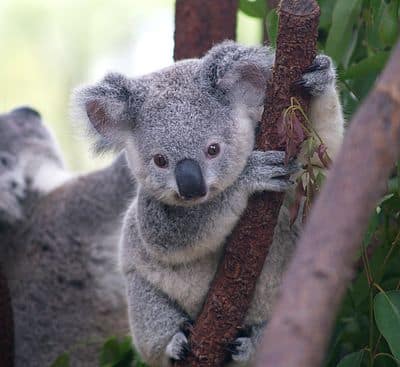Coala (Phascolarctos cinereus) is an Australian herbivore and tree-bearing mammalian species. He is the only living representative of the Phascolarctidae family, and his closest living relatives are vombats. Coalas are found in Queensland, New South Wales, Victoria and South Australia states along Australia’s east and south coasts.

Body lengths vary from 60 to 85 cm, and weights range from 4 to 15 kg. Its fur is in colors between silvery gray and chocolate. Individuals in northern populations are generally smaller and lighter than those living in the south. The issue that these two populations are subspecies is controversial.
Coalas, who obtain most of their nutrients from the leaves of eucalyptus trees, generally live in forested areas composed of these trees. Because the nutritional value and calorie content of these leaves are limited, coalas generally lead a sedentary life and sleep up to 20 hours a day. They are social, mother coalas only take care of their offspring as long as they need care. Adult males communicate with loud blackberries to intimidate females for intimidating or mating their rivals. Men determine their regions with the scents they secrete from the scent glands in their breasts. Since they are among the marsupials, coala puppies are born after they have not completed their development and crawl into their mothers’ pouch and spend the first six to seven months of their lives here. Puppies are weaned in one year. coalas have not many natural enemies and parasites; however, Chlamydiaceae bacteria and some pathogens such as coala retrovirus are affected by forest fires and drought.
coalas have been hunted by Australian Aborigines for thousands of years, depicted in mythology and cave paintings. The first European-known encounters with coalas took place in 1798, and a picture of the animal was published in 1811 by George Perry. Although Robert Brown made the first detailed scientific description of the species in 1814, this work was not published for 180 years. John Gould both identified and painted the coala and made it known in the UK. Other details about the biology of coalas were discovered by various British scientists in the 19th century. In the early 20th century, frequent hunting for their fur and widespread culling in Queensland provoked public reaction, and action groups emerged to protect the species. In this context, animal shelters were established, and the coala, whose habitat was fragmented and decreased, were transferred to new areas. They face the threat of destruction of their habitats due to agriculture, urbanization, drought and forest fires due to climate change. coalas are listed among the sensitive species in the IUCN Red List by the World Association for Conservation of Nature and Natural Resources.




